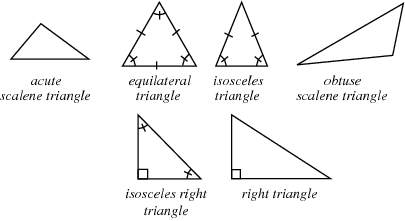Today our focus was on the six types of triangles. Our learning goal was to identify the types of triangles (acute, obtuse, right, equilateral, isosceles and scalene) by looking at the angles and side attributes. I got the idea for this activity from Interactive Math Journal from Runde's Room.
To begin, I did another formative assessment with the classes. This time the assessment is called "Always, Sometimes, Never." I found this assessment idea in the book, Mathematics Formative Assessment by Page Keeley and Cheryl Rose Tobey. The students were presented with 8 statements about triangles. They needed to think about what they already knew about triangles and use this information to help them to choose "always, sometimes, or never" and justify their thinking. The eight statements are below:
- Triangles are named by their angles.
- Triangles are named by the number of congruent sides.
- A right triangle has two right angles.
- An acute triangle has all acute angles.
- An obtuse triangle has three obtuse angles.
- An equivalent triangle has 3 congruent sides and angles.
- A triangle can have two names.
- I know the difference between isosceles and scalene triangles.
We answered the first statement individually, then I asked the kids to move to one of three corners of the room. Once they were in their corner, I asked them to discuss their answers with the others to find commonalities and generate discussion and thinking. Then, we shared thoughts from each of the groups so that I could hear how they were processing the statements and answers. We repeated this process with each statement. There were a few instances where I would work with them to find the correct answer, but most of the statements would be discussed during our note taking.
Next, I handed each student a sheet of paper with six triangles on them. We numbered the triangles and cut them apart in two long strips so that I did not have to spend much class time cutting apart six triangles! We taped the strips into our journal and then took notes about each one. We began by breaking the triangles into two groups (1) those that are named for their angles and (2) those that are named for the number of congruent sides. By the end of the note taking, I wanted the kids to understand that triangles have two names. They have a name for their angles AND a name for their sides (i.e. right, scalene triangle or acute, equilateral triangle, etc.)
Once we had taken the notes, we revisited our formative assessment page to discuss how we would answer the statements now:
- Triangles are named by their angles: Sometimes (acute, obtuse, right)
- Triangles are named by the number of congruent sides: Sometimes (equilateral, isosceles, scalene)
- A right triangle has two right angles: Never
- An acute triangle has all acute angles: Always
- An obtuse triangle has three obtuse angles: Never
- An equivalent triangle has 3 congruent sides and angles: Always
- A triangle can have two names: Always (one for the angles AND one for the sides)
- I know the difference between isosceles and scalene: Always (if I make sure to use my journal)
Finally, I wanted the kids to come up with a mnemonic device to help them remember the six types of triangles. An example would be:
Order of Operations?
PEMDAS
I also asked them to tell me how they will remember the differences between the six triangles.... not just the names of the triangles.
HOMEWORK: Countdown 5.3




No comments:
Post a Comment